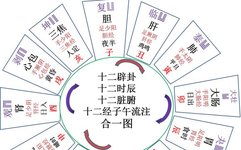We will first present the diagram of the twelve meridians along with the twelve hexagrams, twelve time periods, and twelve organs, as shown below, and then proceed with further research.
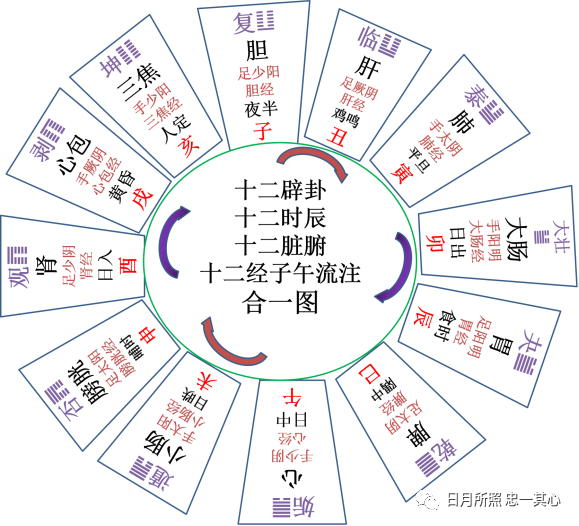
1. Summary of Human Meridians and Naming of the Twelve Meridians
Ancient scholars emphasized the interaction of Yin and Yang, stating that the interaction of Yin and Yang leads to the transformation of the universe and the birth of all things; the union of male and female creates life. (from the Book of Changes, Commentary)
The heart, pericardium, lungs, liver, spleen, and kidneys, are the six Zang organs, with six meridians, belonging to Yin; the stomach, gallbladder, triple warmer, bladder, large intestine, and small intestine, are the six Fu organs, with six meridians, belonging to Yang.
The six Zang meridians and six Fu meridians are collectively known as the twelve meridians, which circulate continuously in the human body, referred to as flow. The Yin of the Zang and the Yang of the Fu complement each other; the foot Yin and hand Yang each have three Yin and three Yang meridians, totaling twelve meridians, distinguishing them from the eight extraordinary meridians and other collateral meridians.
The meridians of the human body include twenty meridians (twelve regular meridians, eight extraordinary meridians), and fifteen collateral meridians; in addition to the collateral meridians, there are also the subsidiary meridians, as shown in the diagram below:

The twelve meridians of the Zang and Fu are also known as “regular meridians”: named according to the principle of the “three-in-one” of hands and feet, Yin and Yang, and Zang and Fu.
Three Yin Meridians of the Hands: Hand Taiyin Lung Meridian, Hand Jueyin Pericardium Meridian, Hand Shaoyin Heart Meridian.
Three Yang Meridians of the Hands: Hand Yangming Large Intestine Meridian, Hand Shaoyang Triple Warmer Meridian, Hand Taiyang Small Intestine Meridian;
Three Yin Meridians of the Feet: Foot Taiyin Spleen Meridian, Foot Jueyin Liver Meridian, Foot Shaoyin Kidney Meridian.
Three Yang Meridians of the Feet: Foot Yangming Stomach Meridian, Foot Shaoyang Gallbladder Meridian, Foot Taiyang Bladder Meridian.
2. Principles and Cycles of the Flow of the Twelve Meridians
Please note: The flow of the twelve meridians refers to the operation of Ying Qi within the meridians, and should not be confused with Wei Qi. In other words, the flow of the twelve meridians does not mean that the twelve meridians themselves rotate continuously according to the twelve time periods, but rather that Ying Qi flows in accordance with the positional sequence of the twelve meridians, circulating endlessly, as the positions of the twelve meridians in the human body are relatively stable.
The Ming dynasty physician Zhang Jiebin (Jingyue) commented in his work “Classified Essentials: Volume Seven on Meridians: Twelve Meridians” on the “Spiritual Pivot: Meridians”: “In my humble opinion, these twelve meridians refer to Ying Qi. Ying flows within the meridians, and the sequence must begin with the Lung Meridian, as the Qi flows through the meridian, returning to the lungs, which govern the hundred meridians to regulate Yin and Yang, and all five Zang and six Fu organs receive Qi. Therefore, the twelve meridians take the Lung Meridian as the lead, passing in sequence until reaching the Foot Jueyin Liver Meridian, and then returning to the Lung, completing a cycle.“
Combining this with the upcoming interpretation of the “Huangdi Neijing: Ling Shu: Ying Qi”, it can be understood that the flow within the twelve meridians refers to Ying Qi.
In the diagram of the twelve meridians, on one hand, each meridian circulates continuously; on the other hand, each of the twelve meridians governs a specific time period, so the flow diagram of the twelve meridians must be understood in conjunction with the twelve time periods, which are cyclical, just as the twelve meridians are cyclical.
The flow of Ying Qi in the twelve meridians mainly follows five major principles:
1. Distribution Principle: Symmetrical on the Left and Right. Distributed in the head, face, trunk, and limbs, covering the entire body.
The six Yin meridians are distributed on the inner sides of the limbs and the chest and abdomen—belonging to Yin.
The six Yang meridians are distributed on the outer sides of the limbs and the head and face (the higher parts are Yang) and the trunk—belonging to Yang.
2. Arrangement Principle: Front, Middle, and Back as the Basis
The three Yang meridians of the hands: front, middle, back; the three Yin meridians of the hands: front, middle, back.
The three Yin meridians of the feet: lower half, front, middle, back; the middle part has intersections; upper half, front, middle, back.
3. Flow Principle: Yin Ascends, Yang Descends—Yin meridians ascend, Yang meridians descend
Standing posture, both hands raised.
Yin Ascends:
The three Yin meridians of the hands (Hand Taiyin Lung Meridian, Hand Jueyin Pericardium Meridian, Hand Shaoyin Heart Meridian) flow from the chest to the hands; the three Yin meridians of the feet (Foot Taiyin Spleen Meridian, Foot Jueyin Liver Meridian, Foot Shaoyin Kidney Meridian) flow from the feet to the chest and abdomen.
Yang Descends:
The three Yang meridians of the hands (Hand Yangming Large Intestine Meridian, Hand Shaoyang Triple Warmer Meridian, Hand Taiyang Small Intestine Meridian) flow from the hands to the head; the three Yang meridians of the feet (Foot Yangming Stomach Meridian, Foot Shaoyang Gallbladder Meridian, Foot Taiyang Bladder Meridian) flow from the head to the feet.
4. Connection Principle: Exterior and Interior Yin and Yang Meridians Connect at Four Extremities; Same Named Hand and Foot Yang Meridians Connect at Head and Face; Hand and Foot Yin Meridians Connect at the Chest
① Exterior and interior Yin and Yang meridians connect at four extremities. Mutual exterior and interior meridians connect at the fingers and toes. The heart and small intestine, pericardium and triple warmer, liver and gallbladder, spleen and stomach, kidney and bladder, lung and large intestine, are mutual exterior and interior meridians. For example, the three Yin meridians of the hands flow from the chest to the hands, while the three Yang meridians of the hands flow from the hands to the chest, connecting at the fingertips; more specifically, the Hand Taiyin Lung Meridian and Hand Yangming Large Intestine Meridian intersect at the index finger.
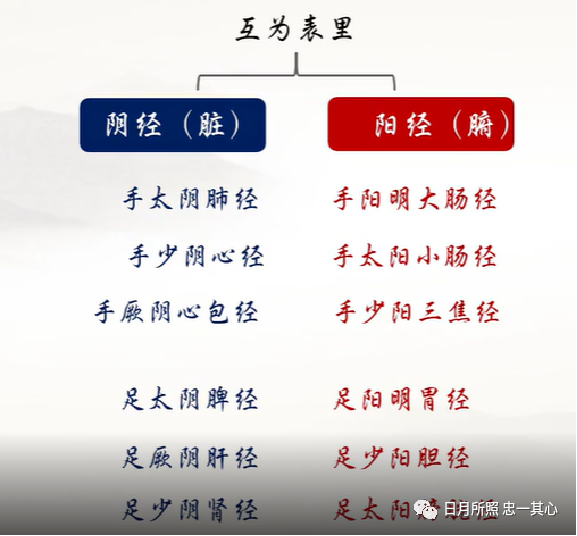
② Same named hand and foot Yang meridians connect at the head and face. For example, the Hand Yangming Large Intestine Meridian flows from the hand to the head and then descends to connect with the Foot Yangming Stomach Meridian. The Foot Yangming Stomach Meridian flows from the head and face to the chest, enters the abdomen, and descends to the feet. The Hand Yangming Large Intestine Meridian and Foot Yangming Stomach Meridian connect at the head and face.
③ Hand and foot Yin meridians connect at the chest. For example: the Foot Taiyin Spleen Meridian connects with the Hand Shaoyin Heart Meridian at the heart; the Foot Shaoyin Kidney Meridian connects with the Hand Jueyin Pericardium Meridian at the chest; the Foot Jueyin Liver Meridian connects with the Hand Taiyin Lung Meridian at the lung.
5. Qi and Blood Flow Principle: Starting and Ending with Hand Taiyin Lung Meridian, Circulating Endlessly, Like a Loop Without End
Flowing from above is called flow, and flowing down is called infusion.
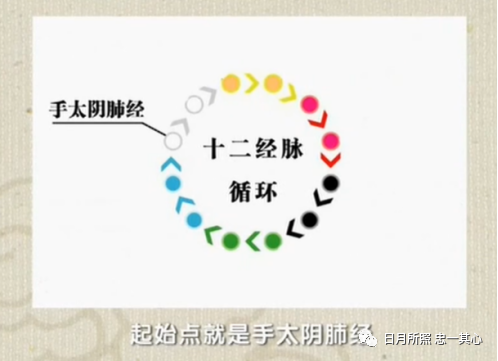
The twelve meridians are the channels for the movement of Qi and blood. Ying and Wei are the Qi and blood of the meridians, with Qi being the commander of blood, and blood being the mother of Qi. The flow of the twelve meridians emphasizes the operational principles of Ying Qi within the meridians, while the operation of Wei Qi follows different principles, which will not be discussed here.
The “Huangdi Neijing: Ling Shu: Ying Qi” states: “The Yellow Emperor said: The way of Ying Qi is that the internal grain is precious. The grain is transmitted to the stomach, then to the lungs, flowing and spreading internally and externally. Those who are specialized in it flow through the meridian tunnels, constantly circulating, endlessly, this is called the record of heaven and earth.“
The Qing dynasty scholar Huang Yuanyu’s commentary on “Ling Shu: Xuan Jie: Ying Qi” states: “Ying and Wei are the Qi and blood of the meridians; Qi flows outside the meridian as Wei, and blood flows within the meridian as Ying. Both Ying and Wei Qi are transformed from food and grain, hence the way of Ying Qi is to treasure the internal grain. Ying Qi is the Qi within the blood vessels. Grain enters the stomach, is digested by the spleen, the spleen Qi disperses essence, and then transmits it to the lungs. The lungs govern Qi, Qi transforms into fluids, and fluids overflow internally, while Qi spreads externally. Those who are fierce flow outside the meridian, which is Wei Qi. Those who are specialized flow through the meridian tunnels, which is Ying Qi. (The term “tunnel” refers to the path within the meridian. The “Zuo Zhuan” states: The Duke of Jin requested a tunnel. The commentary states: A tunnel is a path for burial. The meridian tunnel is the path within the meridian). Constantly circulating without end (Ying means to flow. The “Book of Songs” states: “Ying Ying Qing Fly”. The commentary states: Ying Ying refers to the appearance of coming and going), endlessly, this is called the record of heaven and earth.”
The essence and Qi of food and grain are stored in the lungs, which govern the distribution and circulation of Qi throughout the body. “Those who are fierce flow outside the meridian, which is Wei Qi. Those who are specialized flow through the meridian tunnels, which is Ying Qi.“
“Those who are specialized” refers to Ying Qi. How does Ying Qi flow within the meridian tunnels of the twelve meridians, “constantly circulating, endlessly“?
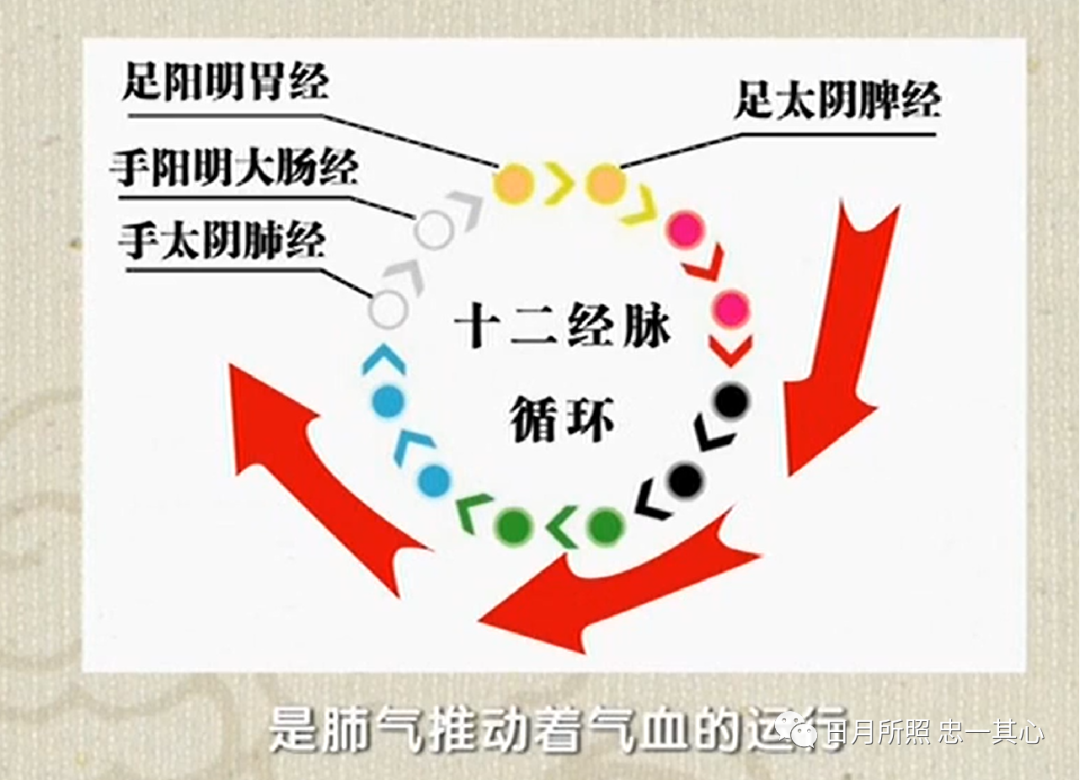
Next, the “Huangdi Neijing: Ling Shu: Ying Qi” continues:
“Therefore, Qi (i.e., Ying Qi) flows from the Hand Taiyin (Lung Meridian), infusing into Yangming (Hand Yangming Large Intestine Meridian), ascending and infusing into Foot Yangming (Stomach Meridian), descending to the ankle, infusing between the big toes, and merging with Foot Taiyin (Spleen Meridian), ascending to the spleen.
From the spleen, it infuses into the heart, following the Hand Shaoyin (Heart Meridian), exiting the armpit, descending the arm, infusing into the little finger, merging with the Hand Taiyang (Small Intestine Meridian); ascending through the armpit, exiting the inner side, infusing into the inner canthus, ascending to the vertex, descending to the neck, merging with the Foot Taiyang (Bladder Meridian); following the spine, descending to the buttocks, descending to infuse into the tip of the little toe, following the sole of the foot, infusing into the Foot Shaoyin (Kidney Meridian), ascending to the kidneys.
From the kidneys, it infuses into the heart, externally dispersing in the chest, following the heart’s main vessels, exiting the armpit, descending the arm, exiting between the two tendons, entering the palm, exiting at the tip of the middle finger, and returning to the little finger and index finger, merging with the Hand Shaoyang, ascending to infuse into the Zhongfu (Hand Jueyin Pericardium Meridian), dispersing into the Sanjiao (Hand Shaoyang Triple Warmer Meridian), from the Sanjiao infusing into the gallbladder, exiting the ribs, infusing into the Foot Shaoyang (Gallbladder Meridian). Descending to the ankle, again infusing between the big toes, merging with the Foot Jueyin (Liver Meridian), ascending to the liver.
From the liver, it ascends to the lungs, following the throat, entering the orifices of the jaw, reaching the livestock gate. The branches diverge to the forehead, following the vertex, descending to the neck, following the spine, entering the sacrum, which is the Governor Vessel; the collateral Yin organs ascend through the hair, entering the navel, ascending through the abdomen, entering the diaphragm, descending into the lungs, and returning to the Hand Taiyin (Lung Meridian).
This is the path of Ying Qi, the constant of reverse and forward.
From this, it can be seen that Ying Qi starts from the Hand Taiyin Lung Meridian, sequentially flowing into the Hand Yangming Large Intestine Meridian, Foot Yangming Stomach Meridian, Foot Taiyin Spleen Meridian, Hand Shaoyin Heart Meridian, Hand Taiyang Small Intestine Meridian, Foot Taiyang Bladder Meridian, Foot Shaoyin Kidney Meridian, Hand Jueyin Pericardium Meridian, Hand Shaoyang Triple Warmer Meridian, Foot Shaoyang Gallbladder Meridian, Foot Jueyin Liver Meridian, and finally infusing back into the Hand Taiyin Lung Meridian, then starting the next cycle, Hand Taiyin Lung Meridian… Hand Taiyin Lung Meridian…
Everyone should further comprehend this diagram.

Next time, we will discuss the relationship between the lungs governing Qi and the diagram of the twelve meridians, as well as the relationship of the Inch and Taiyuan points of the Hand Taiyin Lung Meridian.

